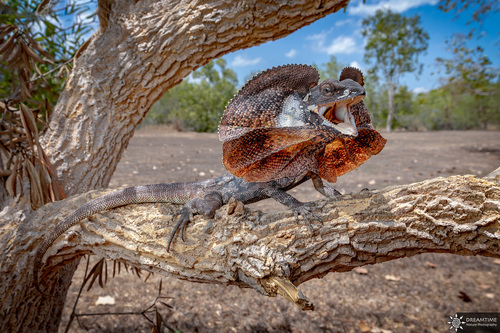
Frilled Lizard
The frilled-neck lizard dazzles with its dramatic neck frill, used to ward off threats. This agile arboreal reptile sprints bipedally to escape danger, playing a crucial role in insect control. Its vibrant display and unique behavior make it an iconic symbol of the Australian wild.
10-20 years
Lifespan
500.0 - 1000.0 g
Weight
Length: 60 - 100 cm
Size
Brown, Yellow, Black, Tan
Color
30 mph
Top Speed
Least Concern
Conservation Status
Unknown
Population Trend
Characteristics
Chlamydosaurus kingii, commonly known as the frilled-neck lizard, is native to northern Australia and southern New Guinea. It is famous for its large, colorful frill around its neck, used for intimidation and display. This arboreal reptile is an excellent climber and can sprint bipedally to escape predators. It primarily feeds on insects and small vertebrates.
Distribution Range of the Frilled Lizard
Chlamydosaurus kingii, commonly known as the frilled-neck lizard, is native to northern Australia and southern New Guinea. In Australia, its distribution spans across the northern regions of Queensland, Northern Territory, and Western Australia.
Frilled Lizard's Habitat
Environmental Conditions
The frilled-neck lizard inhabits tropical and warm temperate environments, preferring savannas, woodlands, and forests. These areas are characterized by distinct wet and dry seasons with temperatures ranging from 20°C to 30°C. The lizard is often found in areas with abundant tree cover, which provides both shelter and opportunities for basking.
Ecological Niche
As an arboreal and terrestrial species, the frilled-neck lizard occupies a niche that involves both ground and tree-based activities. It is an insectivore, primarily feeding on ants, termites, and small vertebrates. Its ability to expand its frill is a key adaptation for communication and defense, aiding in territorial displays and predator deterrence.
Copyright @ Nature Style Limited. All Rights Reserved.
 English
English